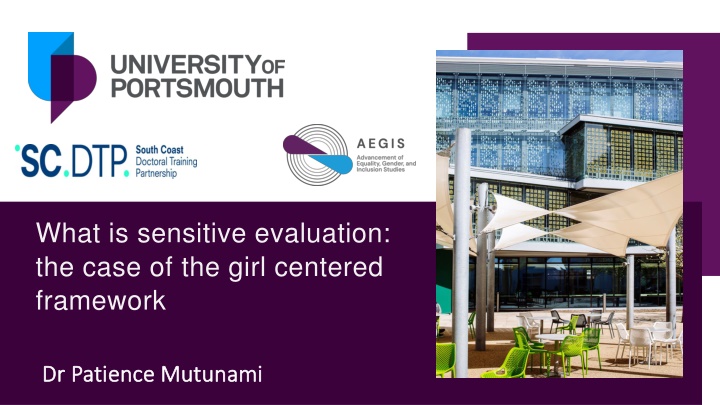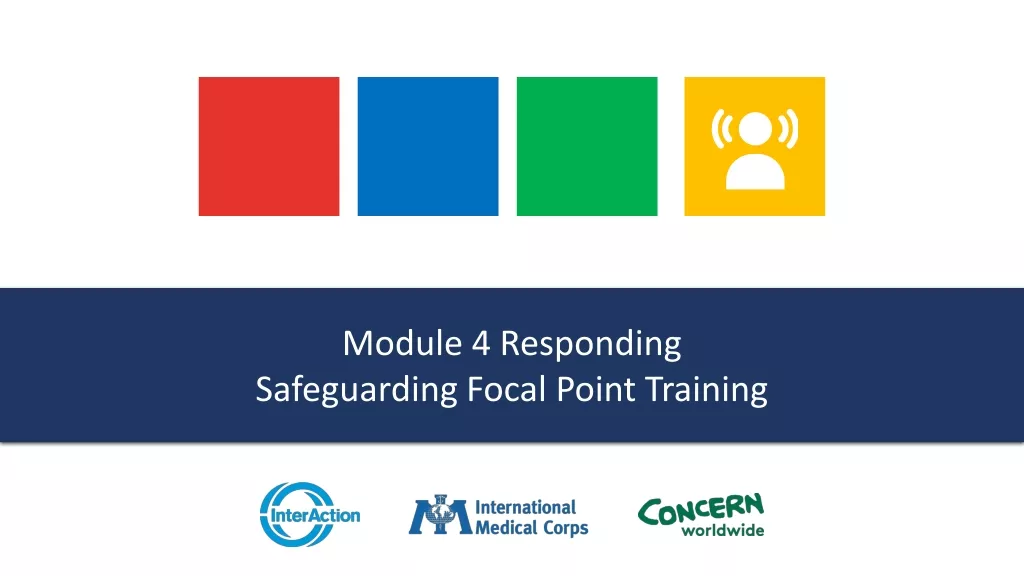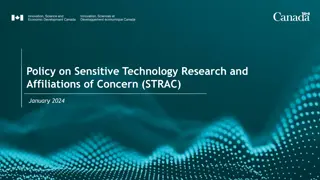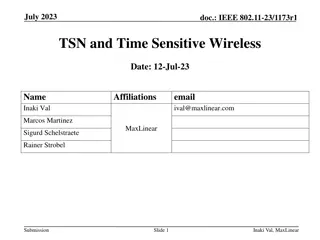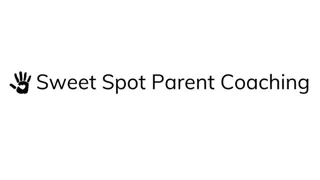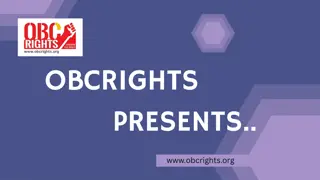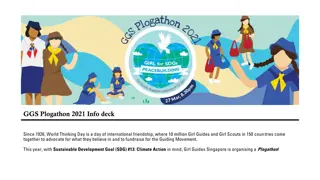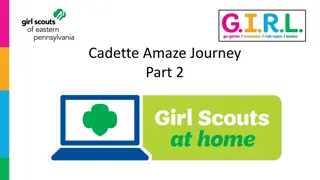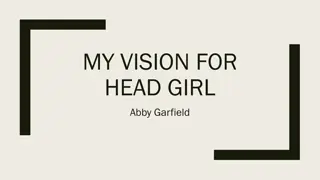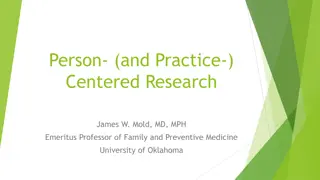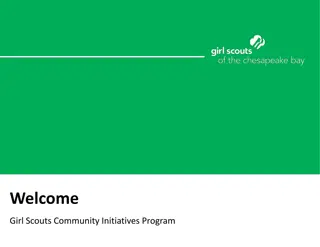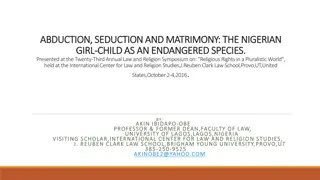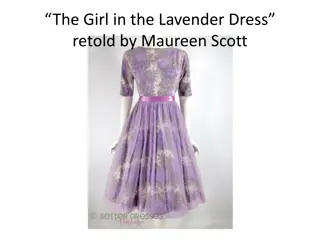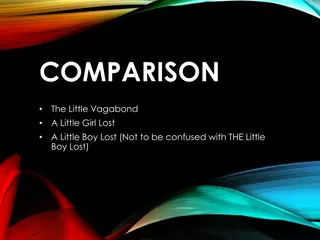Sensitive Evaluation in the Girl-Centered Framework
Dr. Patience Mutunami explores sensitive evaluation within the context of the Africa-led movement to end FGM/C, focusing on the impact of gender equality, sustained engagement, and the role of girls and women in leading change.
Download Presentation

Please find below an Image/Link to download the presentation.
The content on the website is provided AS IS for your information and personal use only. It may not be sold, licensed, or shared on other websites without obtaining consent from the author.If you encounter any issues during the download, it is possible that the publisher has removed the file from their server.
You are allowed to download the files provided on this website for personal or commercial use, subject to the condition that they are used lawfully. All files are the property of their respective owners.
The content on the website is provided AS IS for your information and personal use only. It may not be sold, licensed, or shared on other websites without obtaining consent from the author.
E N D
Presentation Transcript
What is sensitive evaluation: the case of the girl centered framework Dr Patience Mutunami Dr Patience Mutunami
Support to the Africa-led Movement to end FGM/C (2021-27) The Girl Generation- Africa led Movement (TGG-ALM) Funded by the UK s Foreign, Commonwealth, Development Office (FCDO). The programme is implemented by a consortium led by Options with partners Amref Health Africa, ActionAid, Orchid Project, Africa Coordination Centre for Abandonment of Female Genital Mutilation (ACCAF) and University of Portsmouth. Monitoring, Evaluation and Learning technical expertise
Support to the Africa-led Movement to end FGM/C (2021-27) TGG-ALM (2021-2027) seeks to accelerate positive changes in social attitudes towards ending FGM/C in selected regions of Kenya, Ethiopia, Somaliland and Senegal while strengthening the evidence base for what interventions work (and don t work). It builds on a prior UK aid five-year investment from 2013-2018, has a vision of a world where girls and women can exercise their power and rights, have expanded choice and agency, and be free from all forms of violence. The intended impact of TGG-ALM is a reduction in FGM/C by 2027 in focal countries
Programme hypotheses Hypothesis 1: When gender equality is increased, the incidence of FGM/C (a manifestation of gender inequality) will decrease. Hypothesis 2: A sustained movement to end to FGM/C requires the engagement of actors at multiple levels who contribute towards changes in social attitudes and actions to end the practice. Hypothesis 3: The sustained abandonment of FGM/C will be achieved gradually, with many external variables or directly or indirectly contributing.
Programme hypotheses Hypothesis 4: Social diffusion: Changes in norms and attitudes relating to FGM/C (catalysed by programme activities) will diffuse to communities unreached directly by the programme, but linked by geographic proximity, kinship, migration or religious beliefs. Hypothesis 5: Sustained change will happen most effectively when girls and women lead the movement to end FGM/C: The empowerment of girls and women, through a girl centred approach [and through other approaches like supporting women s rights networks and grassroots, women-led groups] will enable them to lead end FGM/C movement and accelerate change towards abandonment. Hypothesis 6: Change requires practitioners to have and use the skills, knowledge and tools to identify and respond to girls rights, needs and aspirations through community dialogues and focused work with boys and girls.
Methodology Baseline sub-national and national PEAs were carried out to provide insights at the individual, household, and community levels and to further provide an understanding of the extent to which the social and gendered norms influence the occurrence and persistence of FGM/C across differentiated population groups. Key Informant Interviews with stakeholders in the community Focus Group Discussions with community members Household surveys with community members
Methodology Longitudinal Panel Community narrator approach, asked with making observations and interpreting everyday social events, noting any shifts in attitudes and patterns pertaining to cultural and gender beliefs within their communities. The narrators were also tasked with engaging in community conversations in order to give insight into the dynamics of social change within their community and the possible underlying causes of those changes. Additionally, narrators were tasked with observing the impact of different actors as potential change agents. Programme sought to understand which stage of change the community narrator s focus was currently at, which stage of change they transitioned from and the ways in which interventions contributed to the change
Methodology Stories of Change Stories of Change were gathered from community members for the purpose of capturing results of the interventions, and to generate learning about how that change happened or if not, what the barriers to change were. Programme partners, community champions and frontline programme staff identified appropriate stories. The sample included young women, boys and men. Where appropriate, community champions were also encouraged to tell their own stories.
Programme design Programming and policies to tackle FGM/C have been rolled out across multiple countries in recent decades. Previous approaches have tended to be top-down, resulting in some positive changes at policy (national) level but widely acknowledged to have had limited effect at the individual and community levels, where social norms and acceptance of FGM/C are embedded. The programme strategy is to co-create, implement, test and adapt interventions to address FGM/C at multiple levels of society in selected locations.
Programme design TGG-ALM operates a bottom-up approach, with girls at the centre because: they are disproportionately affected by FGM/C they are future potential parents and leaders within their communities they are potentially powerful advocates for change. The programme applies the socio-ecological model whereby locally led interventions are implemented sub-nationally at individual, household, community and county levels, and nationally All interventions are underpinned by key principles: gender transformative and girl- centred; Do no harm
Interventions- Individual level School clubs Work with girls and boys include End FGM/C school clubs. Partners ActionAid and Amref Health Africa train and support schoolteachers to facilitate conversations within schools, using a specially designed girl-centred curriculum that covers rights, FGM/C, gender, other forms of violence, protection mechanisms, among other topics. Similar activities targeting out-of-school girls have also been implemented.
Interventions- Community level Community dialogues Partners train and support individuals ( Champions ) committed to ending FGM/C to hold various forms of community dialogues, providing them with coaching and training materials. Mother-daughter forums, intergenerational dialogues, men only dialogues There is a range of local activities to end FGM/C through media, arts, schools, community meetings, survivor forums and policy advocacy. Partners support movement building in a range of ways: convening women s rights and youth networks, training and amplifying the voices of survivors to promote their leadership of the end FGM/C movement.
Interventions- County level Multi-sectoral interventions have been implemented to support an enabling policy environment at County level: Promoting the enforcement of FGM/C law, gender and child protection policies, and the implementation of those frameworks into County integrated development plans. Formation of and engagement in Gender Technical Working Groups and Children Advisory Councils to strengthen local surveillance systems for at risk girls and reporting systems for FGM/C cases and other forms of violence against girls.
Interventions- National level In Kenya, a pre-service training curriculum for health professionals on FGM/C prevention and response has been developed and is being rolled out in universities and colleges. The training covers the shift towards medicalisation of the practice. Training lecturers, who in turn train healthcare students from universities and mid- level colleges, health care workers and community health promoters. The Africa Coordination Centre for Abandonment of FGM/C (ACAAF) are rolling out a standardised FGM/C prevention and response pre-service training curriculum in health training institutions.
Evaluation- synergies across the socioecological model Stakeholders applauded the programme s approach of working at multiple social levels targeting multiple target groups. The development of networks and movements reveal evidence of positive shifts in attitudes around FGM/C in communities. Specifically, many communities are now viewing FGM/C as a form of violence with adverse effects on health and wellbeing, seeing it as a driver of school dropouts, a violation of human rights, and against religious teachings. Community interventions are reportedly helping reduce stigma towards uncut girls and women. Champions , often survivors, are now leading community forums, with some acting as watchers , to whom girls and community members can report cases of FGM/C.
Evaluating the GCF- Outputs Sensitive topic- working with organizations that have community relationships creates an enabling environment with organizational staff, which include counsellors, social workers, teachers etc Main challenge is difficulty of gathering evidence that's rigorous enough to evidence the success of the GCF The GCF promotes messaging around bodily autonomy and empowerment and the impact that it has on girls and their levels of agency and their ability to negotiate and influence decisions that affect them Evidencing that it has happened is difficult Tensions between the programme having to evidence that the GCF is working versus what the data allows us to say
Evaluating the GCF- Outputs Methodological challenges- longitudinal panel ran for a year Initial findings demonstrated positive shifts in knowledge, attitudes, and beliefs among school club attendees. Change couldn t be tracked beyond that year, there's tension with programming in terms of funding
Conclusion Girls voices, experiences and insights are key to the development of effective, sustainable and scalable programmes. It is crucially important to trust, listen to, and partner with girls, and ensure they are leading the change to combat FGM/C Sensitive approaches are needed to achieve this
